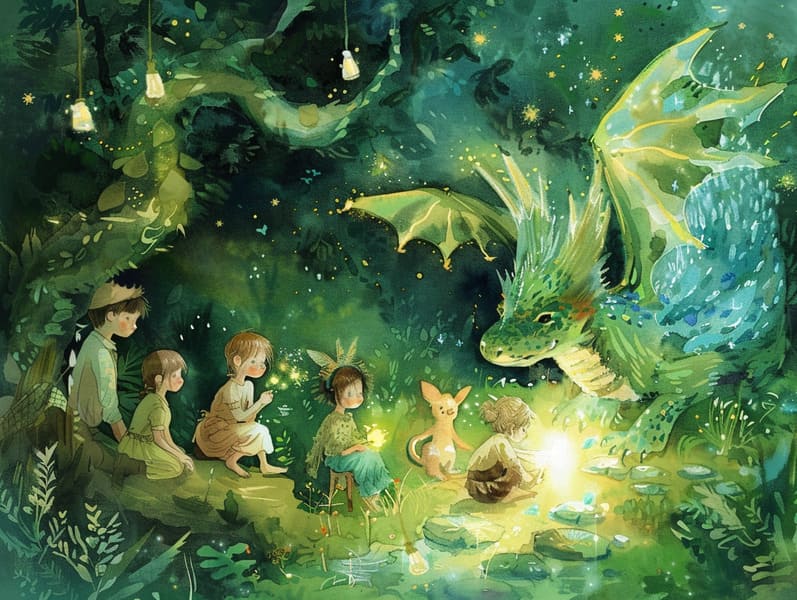
Popular fairy tales have historical significance. These narratives have been shared from one generation to the next ages before they were ever published. They originated from a variety of civilizations, including European traditions. They were initially conveyed among adults, often carrying themes and messages concerning the societal norms and beliefs of the time.
Jacob and Wilhelm Grimm, Jacob and Wilhelm, were among the first to collect and release many of these beloved fairy tales. Their compilation, "Grimm's Folk Tales," included stories like "Cinderella," "Hansel and Gretel," and "Snow-White and Rose-Red," which have since become cornerstones in the world of children's fairy tales. Similarly, H. C. Andersen's whimsical narratives, such as "The Mermaid," and "The Ugly Duckling," have captivated hearts worldwide, securing their place in the pantheon of beloved fairy tales.
Though they are centuries old, classic fairy tales remain as impactful as ever, especially as bedtime stories for kids. These enchanting tales are now available in diverse formats, including artistically illustrated books, fantastical animations, and online storybooks.
Their ongoing significance can be linked to several magical reasons:
Life Lessons: Timeless fairy tales often share important moral lessons. Narratives like "The Boy Who Cried Wolf" teach the significance of truthfulness, while "The Tale of the Tortoise and the Hare" demonstrate the qualities of resolve and humbleness. These tales offer children clear distinctions between right and wrong, building their moral compass in a gentle yet profound way.
Kindness and Comprehension: Classic fairy tales frequently feature heroines facing challenges and problems, inspiring audiences to connect with their struggles and back their triumphs. For instance, "Beauty and the Beast" demonstrates the importance of appreciating inner worth to understand the inner being of a being, promoting compassion and understanding.
Cultural Appreciation: Many old fairy tales are steeped in the cultural contexts from which they blossomed. Engaging with these tales can provide captivating looks into different historical contexts, encouraging a sense of world respect and understanding.
Creativity and Fantasy: The fantastical elements in traditional fairy tales—talking beasts—ignite children’s visions and dreams. These fairy tales transport readers to fantasy realms, promoting inventive ideas and a sense of magic that persists a lifetime.
Old fairy tales are not only entrancing but also instructive. They work as magical tools in developing various intellectual and emotional capacities in the young. When ancient fairy tales are narrated, they advance communication skills by bringing new vocabulary and complicated sentence structures. This practice also develops auditory skills and attention, as young readers track the narrative, anticipating to see what happens next.
Furthermore, examining the themes and characters of timeless fairy tales can foster evaluative skills and cognitive skills. Little ones are led to discern patterns, foresee events, and understand cause and effect. These conversations also further the young voice their thoughts and feelings, advancing their emotional intelligence.
In today’s technological era, the proliferation of digital storybooks has made these fairy tales more obtainable than ever. Internet resources and apps extend extensive collections of old fairy tales that can be explored or listened to anytime, anywhere. Fairy tales spoken are particularly common, making available an charming way for young ones to delight in these charming stories. Spoken stories and spoken videos take characters and settings to life, often supplemented by mesmerizing soundtracks and songs that find it here augment the narrative experience.
The timeless fascination of timeless fairy tales lies in their ability to shift to present eras while staying true to their core values. Contemporary versions of these stories often present more inclusive figures and modern settings, making them relevant to today’s audience. However, the essential messages of daring, sympathy, and integrity remain unchanged, continuing to move young readers of all ages.
Old fairy tales also offer a sense of assurance and homeliness. They deliver up a neat narrative with a apparent beginning, middle, and end, often drawing to a close with the termination of conflicts and the triumph of good over bad. This regularity can be calming for young readers, extending a sense of sturdiness in an constantly changing world.
Traditional fairy tales continue to spellbind and inform new generations, maintaining their beauty and meaningfulness in modern society. As kids' bedtime tales, they impart upon a perfect blend of wonder and wisdom, boosting moral values, empathy, and creativity. The proliferation of online fairy tales and the commonness of fairy tales recited guarantee that these ancient narratives remain attainable to new generations.
By defending and communicating these fairy tales, we continue to venerate the rich tapestry of tales and cultural heritage. Whether you are perusing a artistically illustrated book, discovering a virtual library, or listening on an sound book, the majesty of traditional fairy tales is always within reach. These stories show us of the unwavering impact of tales and its ability to unify us across generations and cultures.
Regardless if you are browsing a richly illustrated book, discovering a web-based library, or listening on an audio story, the grandeur of famous fairy tales is always within reach.
These tales illustrate of the everlasting spell of narratives and its ability to bring us together across eras and regions, forming a connection that captivates and teaches alike.